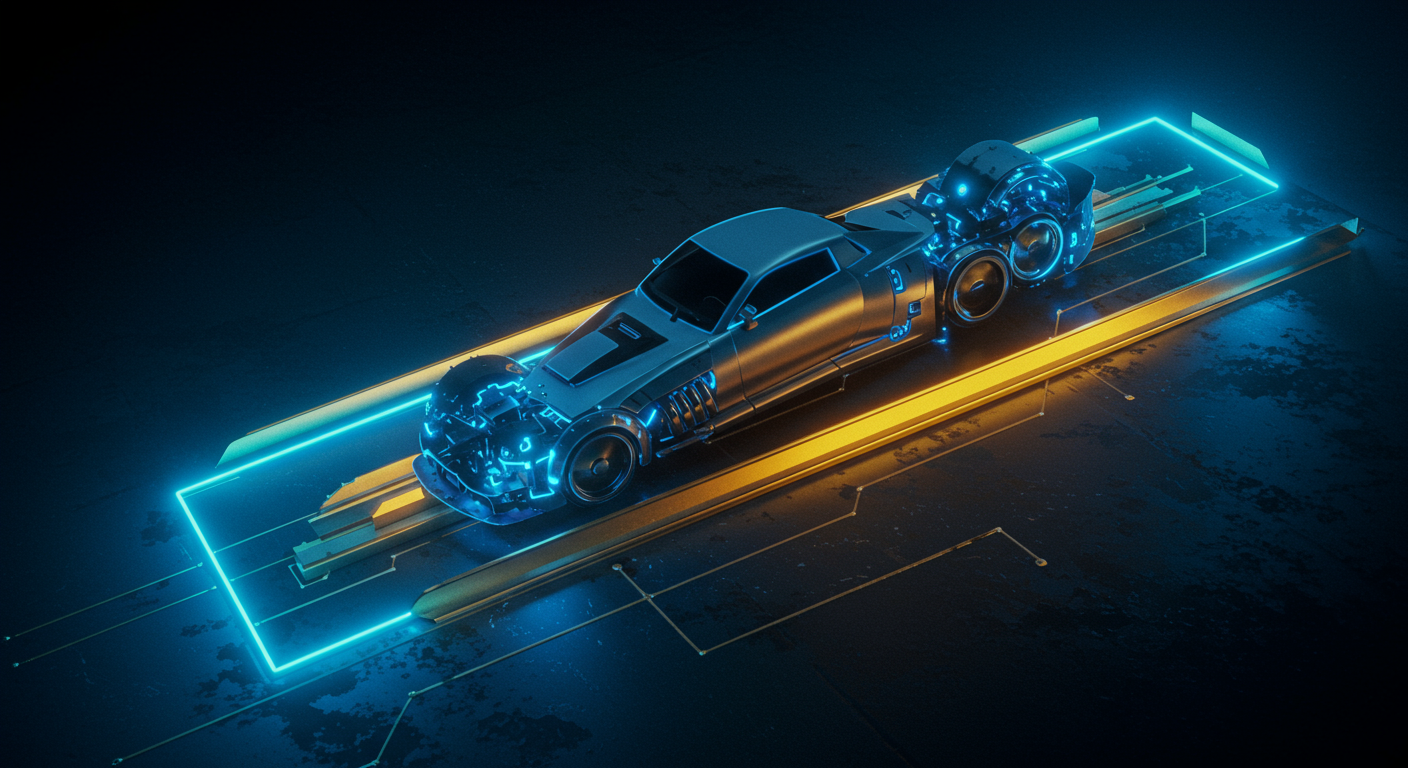Qwen-Image Edit: AI Photo Editing Redefined – Is Photoshop Obsolete?

Qwen-Image Edit: The AI Revolution in Photo Manipulation
Forget everything you thought you knew about photo editing, because a new contender has entered the ring, and it's armed with AI.
Meet Qwen-Image Edit
Qwen-Image Edit from Alibaba is a game-changer. It's an AI tool that can perform complex photo edits based on simple text prompts. Think of it as Photoshop, but you’re the director, not the technician. For example, you could type "add a flock of seagulls flying over the beach" and voila! seagulls appear, realistically integrated into the scene. AI image generation tools have never been more powerful!
How Does It Stack Up?
- Compared to Photoshop: Qwen-Image Edit lowers the barrier to entry significantly. No more struggling with layers and complex tools. Just type what you want.
- Alibaba's Pedigree: Alibaba, the force behind the Qwen series, already boasts impressive AI models. This isn't their first rodeo.
Is Photoshop Obsolete?
Not yet. Photoshop still offers granular control for professionals. But for everyday users and even some professionals, Qwen-Image Edit could streamline workflows and unlock creative possibilities previously out of reach. It's a tool that could empower content creators, graphic designers, and anyone who wants to easily manipulate images.
Qwen-Image Edit represents a significant step forward in AI-powered image editing. It's a tool to watch closely, and it hints at a future where creative tools are far more intuitive and accessible.
Qwen-Image Edit is making waves with its promise to redefine photo editing, prompting some to question if Photoshop's reign is nearing its end.
How Qwen-Image Edit Works: Under the Hood
So, what's the secret sauce? While the specifics are closely guarded (standard procedure, wouldn't you agree?), we can piece together the high-level architecture driving Qwen-Image Edit. Think of it as a symphony of specialized AI models working in harmony.
- Foundation Model: At its core lies a powerful foundation model, likely trained on a massive dataset of images and text. This enables it to understand the intricate relationship between visual content and language. It's the brain behind the operation.
- Text-to-Image Translation:
- The system takes your textual instructions – "add a cat wearing sunglasses" – and translates them into a visual representation.
- This involves complex natural language processing (NLP) to understand the nuances of your request.
- Imagine teaching a computer to "see" what you're describing!
In-Painting and Out-Painting
"The true sign of intelligence is not knowledge but imagination." - Albert Einstein (circa 2025)
In-painting fills in missing or unwanted parts of an image seamlessly. Need to remove a photobomber? Poof!* Gone.
- Out-painting expands the boundaries of an image, generating content beyond the original frame. Want to turn a portrait into a landscape? No problem.
- These capabilities rely on generative models that can convincingly create new pixels based on the surrounding context. This is different from a simple content Image Background Remover.
Context and Quality
- Qwen-Image Edit excels at understanding context. It doesn't just add elements randomly; it considers lighting, perspective, and style to ensure a cohesive result.
- Preserving image quality is paramount. The AI strives to generate high-resolution, artifact-free results. No one wants a blurry, pixelated masterpiece!
Training Data
The performance of Qwen-Image Edit is heavily influenced by its training data. While the exact sources are proprietary, it likely includes a diverse range of images and corresponding captions to teach the model about visual concepts and relationships. The better the training data, the smarter the AI becomes, and more accurate its interpretations will be.
In conclusion, Qwen-Image Edit harnesses the power of advanced AI models and vast datasets to offer powerful photo editing capabilities. It moves beyond simple filters and towards genuinely creative manipulations, opening new possibilities for graphic designers and content creators alike. Next, we'll delve into whether this technological leap truly spells doom for traditional tools like Photoshop.
Alright, let's dive into what Qwen-Image Edit can really do. It's more than just a filter, trust me.
Key Features and Capabilities: What Can Qwen-Image Edit Do?

This isn't your grandma's photo editor; we're talking serious AI magic. Qwen-Image Edit brings a new level of sophistication to image manipulation. Think of it as a digital artist in your pocket.
- Object Removal: Ever wish that photobomber wasn't in your otherwise perfect shot? Gone. Qwen-Image Edit can intelligently remove objects, seamlessly filling in the background. It's like they were never there.
- Background Replacement: Transport yourself! Replace drab backgrounds with anything from tropical beaches to futuristic cityscapes. The AI handles the blending, so it looks remarkably natural. For example, a graphic designer could easily experiment with Design AI Tools alongside this editing tool.
- Style Transfer: Want to make your photo look like a Van Gogh painting or a modern digital artwork? Style transfer lets you apply the aesthetic of another image to yours.
- Precision and Accuracy: This AI doesn't just slap on effects. It understands the image context, ensuring edits are accurate and don't create weird artifacts. The precision is impressive, even on complex edits.
- Speed and Efficiency: Forget spending hours in clunky software. Qwen-Image Edit gets the job done fast. This is especially useful for content creators managing large volumes of images.
- Complex Edits: We're not just talking about basic touch-ups. Qwen can handle intricate tasks like relighting a scene or changing the texture of a surface.
Qwen-Image Edit is making waves, but how does it stack up against the industry standard, Adobe Photoshop?
Qwen-Image Edit vs. Photoshop: A Head-to-Head Comparison

The Qwen-Image Edit tool allows users to edit photos with the power of AI. Let's dive into a feature-by-feature comparison against the stalwart Adobe Photoshop, a tool that has long been a graphics industry standard for image creation and manipulation.
- Features:
- Qwen-Image Edit excels in AI-driven tasks:
- Generative Fill: Think replacing backgrounds or adding objects with a simple text prompt.
- Object Removal: Seamlessly erase unwanted elements.
- Photoshop boasts a broader range of manual tools:
- Precise selections, layers, and masking options for granular control.
- Advanced retouching and color correction.
- Ease of Use:
- Qwen-Image Edit prioritizes simplicity – a shallow learning curve means quicker results for those new to image editing.
- Photoshop has a steeper learning curve; mastering it takes dedicated study and practice to utilize its depth of features effectively. New users might prefer to ease into design through AI tools like Adobe Express.
- Cost-Effectiveness:
- Qwen-Image Edit aims to be the budget-friendly option, it can be free or offer competitive subscription pricing, making advanced photo editing accessible.
- Photoshop operates on a subscription basis, representing a larger ongoing investment.
- Workflow Efficiency:
- Qwen-Image Edit speeds up specific tasks with AI, like removing watermarks from images using an AI Watermark Remover, and quickly generating variations.
- Photoshop requires more manual steps for similar results but provides complete creative freedom.
- Limitations:
- Qwen-Image Edit might sacrifice fine-tuned control for the sake of automation.
- Photoshop can be time-consuming, and requires a good understanding of image editing techniques.
Hands-On Review: Our Experience with Qwen-Image Edit
Qwen-Image Edit is making waves, promising to redefine how we approach photo editing with AI, so we put it through its paces to see if it lives up to the hype. This tool helps you make edits directly within images, using natural language prompts. Qwen-Image Edit is an impressive option for quick, AI-driven image enhancements.
Editing Examples and Results
We tested a variety of edits, from simple object removal to more complex transformations like changing the style of clothing or adding specific elements.
For example, we successfully removed a distracting background object with a prompt as simple as "remove the trash can".
The results were generally impressive, especially for basic edits. However, more intricate prompts sometimes yielded less accurate results, requiring multiple attempts to achieve the desired outcome.
- Strengths:
- Ease of use with prompt-based editing.
- Fast processing for simple tasks.
- Good at object removal and basic transformations.
- Weaknesses:
- Can struggle with complex or ambiguous prompts.
- Edits may sometimes appear unnatural.
User Interface and Experience
The user interface is clean and intuitive, making it easy to upload images and start editing. The prompt box is prominently displayed, and the results are shown almost instantly. However, the lack of advanced settings or fine-tuning options may limit its appeal for professional graphic designers used to Adobe Photoshop.
Unexpected Findings and Limitations
One surprising finding was its ability to generate realistic reflections and shadows when adding objects, enhancing the overall realism of the edits. On the other hand, we encountered limitations in maintaining consistent detail across larger image sizes, occasionally resulting in blurry or pixelated edits. It's also a reminder that image generation and editing tools, while powerful, are not always a one-click solution.
In summary, our hands-on experience with Qwen-Image Edit reveals its potential as a valuable tool for quick and easy photo editing, but it still has some way to go before truly threatening the dominance of established software. It's a promising glimpse into the future of AI-powered creativity, and we're excited to see how it evolves. For now, explore more top Design AI Tools and get a better result!
Alright, let's get hands-on with Qwen-Image Edit and make some digital magic!
Getting Started with Qwen-Image Edit: A Step-by-Step Guide
Don't let complex AI image editing scare you; think of Qwen-Image Edit as your new creative assistant, ready to bring your visions to life. It's an AI-powered image editor that allows you to modify existing pictures with the help of text prompts. Here's how to dive in:
Accessing and Using Qwen-Image Edit
Unfortunately, Qwen-Image Edit isn't directly available through a simple website or application yet. However, you can usually find it integrated within broader AI platforms or accessed through specific research demos. Keep an eye on the official Alibaba Cloud channels for updates, but it is also avaialble through Hugging Face or ModelScope.
Crafting and Submitting Prompts
The secret sauce is the text prompt! Think of it as your direct line to the AI's imagination. Here’s the breakdown:
- Be Specific: Instead of "fix the sky," try "replace the overcast sky with a vibrant sunset."
- Context is Key: The AI needs to understand the existing image to make smart edits.
- Iterate! Don’t expect perfection on the first try. Refine your prompts based on the results.
Tips and Tricks for Optimal Results
- Start Small: Begin with simple edits before tackling complex transformations.
- Use Keywords: Incorporate artistic styles ("Van Gogh," "photorealistic") or specific object details ("vintage car," "modern architecture").
- Check the Documentation: Often, official documentation (when available) holds the keys to advanced features and prompt formatting.
Common Queries and Troubleshooting
- "Why isn't my edit showing up?" Double-check your prompt for clarity and relevance. The AI might misinterpret vague instructions.
- "How do I revert to the original image?" Look for a "reset" or "undo" button within the interface.
- "Where can I find more examples?" Explore online communities or AI art forums where users share their creations and prompts.
The rise of AI-powered photo editing tools signals a seismic shift, potentially relegating traditional software like Photoshop to the history books.
Predicting Qwen-Image Edit's Trajectory
Where does Qwen-Image Edit go from here? With each iteration, we can anticipate:- Enhanced Realism: Moving beyond simple edits, future versions could master complex manipulations while preserving photorealistic quality.
- Seamless Integration: Expect Qwen-Image Edit and tools like it to integrate directly into creative workflows and other Design AI Tools.
Broader Trends in AI Photo Editing
The momentum extends beyond a single tool; the entire landscape is transforming. The trajectory points towards:- Democratization of Editing: Complex techniques become accessible to everyone, regardless of skill level.
- Hyper-Personalization: AI learns your unique aesthetic preferences, tailoring edits to your specific taste.
- Generative Expansion: Not just editing existing images but creating entirely new photorealistic visuals from text prompts will become commonplace. Tools such as Adobe Firefly lead the charge.
Ethical Considerations and the Future of Creativity
This evolution isn't without its challenges. We're facing:- The Deepfake Dilemma: More powerful tools amplify the risk of malicious image manipulation and misinformation.
- Copyright Concerns: AI training data and generated content raise complex questions about ownership and intellectual property.
- The Redefinition of Creativity: What does it mean to be an artist when AI can mimic and even surpass human skill?
Keywords
Qwen-Image Edit, AI image editing, text-to-image editing, AI photo editing, image manipulation AI, Generative AI for images, Qwen image editor review, AI-powered Photoshop alternative, best AI image editing tools, image editing with AI text prompts, open-source AI image editing, cloud-based AI image editing
Hashtags
#QwenImageEdit #AIGraphics #TextToImage #PhotoEditingAI #ArtificialIntelligence
Recommended AI tools
ChatGPT
Conversational AI
AI research, productivity, and conversation—smarter thinking, deeper insights.
Sora
Video Generation
Create stunning, realistic videos and audio from text, images, or video—remix and collaborate with Sora, OpenAI’s advanced generative video app.
Google Gemini
Conversational AI
Your everyday Google AI assistant for creativity, research, and productivity
Perplexity
Search & Discovery
Clear answers from reliable sources, powered by AI.
DeepSeek
Conversational AI
Efficient open-weight AI models for advanced reasoning and research
Freepik AI Image Generator
Image Generation
Generate on-brand AI images from text, sketches, or photos—fast, realistic, and ready for commercial use.
About the Author

Written by
Dr. William Bobos
Dr. William Bobos (known as 'Dr. Bob') is a long-time AI expert focused on practical evaluations of AI tools and frameworks. He frequently tests new releases, reads academic papers, and tracks industry news to translate breakthroughs into real-world use. At Best AI Tools, he curates clear, actionable insights for builders, researchers, and decision-makers.
More from Dr.

